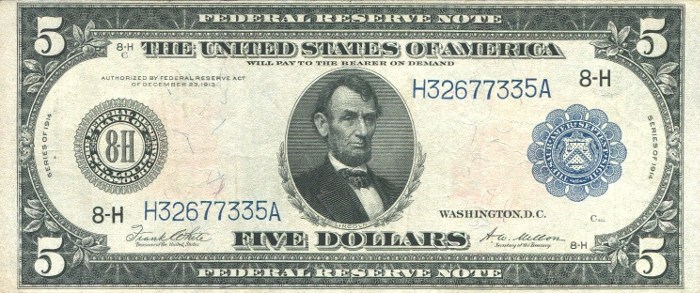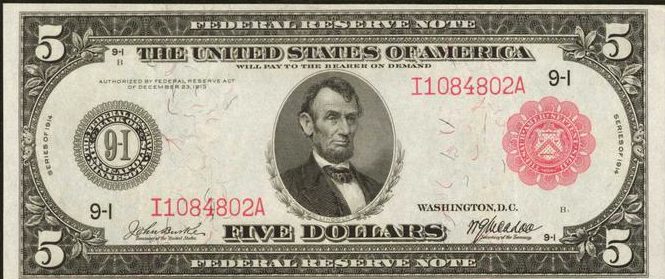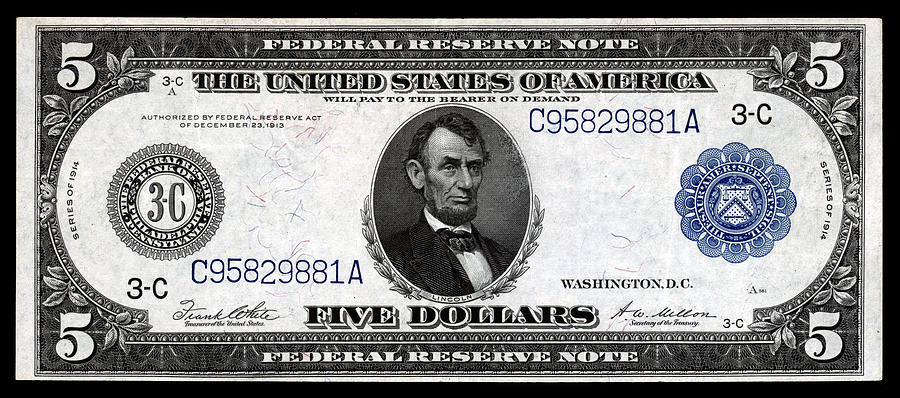The 1914 5 dollar bill is a fascinating piece of American currency that holds significant historical value for collectors and enthusiasts alike. With its unique features, the five dollar bill from the 1914 series is not only a window into the past but also a potential goldmine for those interested in the value and rarity of older bills.
Curious about the value of the 1914 $5 bill, or you want to understand its historical context, this article will take you through the details of this iconic currency and what makes it so special.
The 1914 $5 Bill: What Makes It Special?
The 1914 five dollar bill is part of the Federal Reserve Note series authorized by the Federal Reserve Act of 1913. These bills are often referred to as “blue seal” or “series of 1914” notes due to the distinct blue-colored seal that appears prominently on the right-hand side of the bill.

Despite the “1913” date appearing on the bill, they are generally known as part of the 1914 series, as that was when they were officially issued.
One of the main distinguishing features of the 1914 $5 bill is the image of President Abraham Lincoln. His portrait, which is prominently featured on the obverse side of the bill, has become iconic in American currency.
The reverse side of the bill features two separate scenes that reflect American history: one depicts Christopher Columbus surveying newly discovered land, while the other shows the Pilgrims arriving in America.
The Value of the 1914 5 Dollar Bill
If you’re wondering about the *value* of the 1914 $5 bill, the answer depends on several factors, including the condition of the bill, its rarity, and any unique characteristics it may have. In general, these bills tend to be worth more than their face value of $5 due to their age and historical significance. However, the worth can vary widely depending on the specific bill and its condition.
For example, most 1914 blue seal $5 bills in circulated condition typically have a value of around $60 to $75. In very fine condition, their value increases to around $115 to $125, while in extremely fine condition, these bills can be worth between $185 to $225. Uncirculated bills with a grade of MS 63 can fetch prices ranging from $375 to $550.
Rare Varieties of the 1914 $5 Bill
One of the most intriguing aspects of the 1914 5 dollar bill is that there are several rare varieties that can command premium prices. For example, the F-863B bill, issued by the Federal Reserve Bank of Richmond and signed by White and Mellon, is considered the most valuable.
A bill in very good condition can be worth around $400, and its value can increase significantly with better grades.
In very fine condition, this bill can be worth approximately $1,250, while in extremely fine condition, it can reach around $2,000.
Another rare variety is the F-889 bill, issued by the Federal Reserve Bank of San Francisco and signed by Burke and Glass. This bill’s value is around $135 in very good condition and can climb to about $950 in extremely fine condition.
Similarly, the F-890 bill, also from the San Francisco Federal Reserve Bank, can be worth around $125 in very good condition, with a potential *value* of up to $950 in extremely fine condition.
It’s important to note that these rare varieties are highly sought after by collectors and can represent a significant investment. If you happen to have a rare variety in your collection, you may be sitting on a valuable piece of American history.
Understanding the Grading System for the 1914 $5 Bill
To accurately assess the worth of a 1914 5 dollar bill, collectors rely on a grading system that evaluates the bill’s condition.
The grading system helps determine the bill’s value based on how well it has been preserved over time.

Here are the key grades used to assess five dollar bills:
- Very Good: A bill in this condition has considerable wear and tear. It may have discoloration, creases, and some minor tears. The bill is still recognizable, but it shows clear signs of use.
- Very Fine: A note in very fine condition has been in circulation but is still relatively crisp. There may be some creases or light smudges, but the bill is generally in good shape.
- Extremely Fine: An extremely fine bill shows only small signs of wear and is bright with almost all of its original crispness intact. There might be one or two minor creases, but there are no significant stains or tears.
- MS 63 (Choice Uncirculated): This is the highest grade for a bill that shows no signs of circulation. The bill will still have its original crispness, with no folds or marks, and it will be well-centered.
The higher the grade, the more valuable the bill is. For example, a 1914 $5 bill in mint condition with an MS 63 grade can fetch a significantly higher *value* than one that has been heavily circulated.
The Historical Context of the 1914 Five Dollar Bill
Understanding the historical context of the 1914 $5 bill adds to its appeal for collectors. The series of 1914 was the first to be issued after the Federal Reserve Act of 1913 created the Federal Reserve System.
This act was a significant shift in the way the U.S. managed its currency, creating a central bank responsible for regulating money supply and overseeing national financial stability.
The 1914 five dollar bill is one of the first to bear the new Federal Reserve seal, indicating its role in the country’s monetary system. The bill was printed in response to the growing need for a reliable, centralized banking system, and it reflected the modernization of the U.S. financial infrastructure. With the blue seal and the signatures of key Treasury officials, the bill represented a new era for American currency.
The presence of Abraham Lincoln’s portrait on the 1914 $5 bill further emphasizes the historical significance of the bill. Lincoln, one of America’s most revered presidents, was instrumental in preserving the Union during the Civil War and emancipating enslaved people. His image on U.S. currency symbolizes the nation’s commitment to freedom, equality, and unity, making the 1914 five dollar bill a meaningful collector’s item.
The Appeal of Collecting the 1914 $5 Bill
Collectors are drawn to the 1914 5 dollar bill for a variety of reasons. Its historical significance, aesthetic appeal, and potential value make it an attractive addition to any collection. The blue seal and the intricate design of the bill set it apart from more modern five dollar bills, which often have a simpler look.
Additionally, the rarity of certain varieties, such as those with star symbols at the end of the serial number or the rare signatures, adds an element of intrigue for collectors. These bills are not only valuable in monetary terms but also serve as a reminder of the history and evolution of American currency.
Conclusion: The 1914 5 Dollar Bill
The 1914 5 dollar bill is a remarkable piece of American history that offers both historical insight and potential financial reward. Whether you’re interested in the value of the bill, its rare varieties, or its place in the broader context of U.S. currency, this bill is a fascinating collectible for any enthusiast.
The five dollar bill from 1914 holds significant worth, especially when in good condition or when possessing unique features. For collectors looking to expand their portfolios or individuals simply interested in the history behind the currency, the 1914 5 dollar bill represents a valuable and historically rich piece of the past.
If you’re fortunate enough to own one of these bills, it’s worth getting it professionally graded to determine its value. Looking to sell or just to admire, the 1914 $5 bill is a tangible connection to an important period in American financial history.

